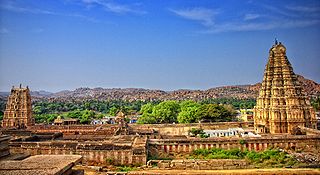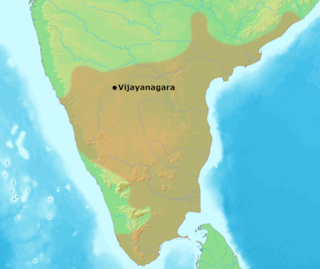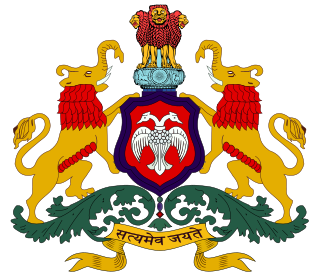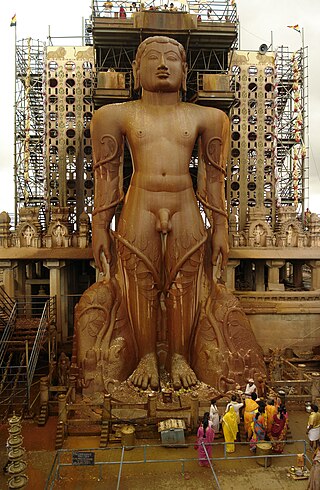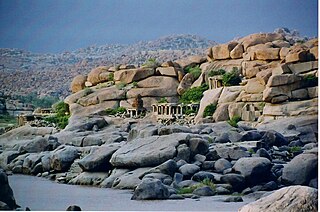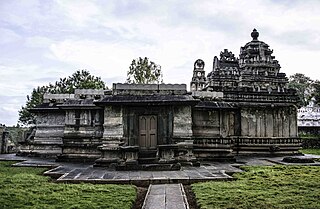The List of Vijayanagara era temples in Karnataka includes notable and historically important Hindu and Jain temples and monoliths that were built or received significant patronage by the kings and vassals of the Vijayanagara Empire during the period 1336-1646 AD. This period includes the rule of the four dynasties: the Sangama, the Saluva, the Tuluva, and the Aravidu dynasties.
| Common name | Photo | Location | District | Year | Notes |
|---|---|---|---|---|---|
| Someshwara [1] |  | Kolar city | Kolar | Early 14th century | According to the Archaeological Survey of India the temple is assignable to the early Vijayanagara period |
| Vidyashankara [2] [3] [4] |  | Sringeri | Chikkamagaluru | 16th century | According to art historian George Michell, the unusual stellate appearance of the temple is due to the influence of Hoysala architecture. |
| Shiva [5] [6] |  | Hemakuta hill, Hampi | Vijayanagara | Early 14th century | Hemakuta group of temples, UNESCO World Heritage Site |
| Shiva [5] [6] |  | Hemakuta hill, Hampi | Vijayanagara | 14th century | Hemakuta group of temples, UNESCO World Heritage Site |
| Shiva [5] [6] |  | Hemakuta hill, Hampi | Vijayanagara | 14th century | Hemakuta group of temples |
| Shiva [5] [6] |  | Hemakuta hill, Hampi | Vijayanagara | 14th century | Hemakuta group of temples, UNESCO World Heritage Site |
| Shiva [5] [6] |  | Hemakuta hill, Hampi | Vijayanagara | 14th century | Hemakuta group of temples |
| Ganagitti (Jain) [7] [8] |  | Hampi | Vijayanagara | c.1385 | An inscription on the site states that the temple was built in A.D. 1385 by lruga, in the reign of King Harihara II, UNESCO World Heritage Site |
| Saavira Kambada Basadi [9] [10] |  | Mudabidri | Udupi | c.1429–1430 | Known locally as the 1000-pillared temple |
| Cheluvanarayana Swamy [11] |  | Melkote | Mandya | c.1458 | Also known as Cheluva Narayana temple, it was built by the local Vijayanagara chieftain |
| Narasimhaswamy [11] |  | Melkote | Mandya | c.15th century | According to historian George Michell, the massive gateway on the hilltop (gopura) is unfinished. |
| Virupaksha [12] [13] [14] |  | Hampi | Vijayanagara | 14th-16th centuries | UNESCO World Heritage Site |
| Temple tank (Pushkarni) [15] [16] |  | Hampi | Vijayanagara | 16th century | Stepped temple tank in Hoysala style, UNESCO World Heritage Site |
| Hazara Rama [12] [13] |  | Hampi | Vijayanagara | c.1406-1542 | UNESCO World heritage site |
| Chandikeshwara [12] [17] |  | Hampi | Vijayanagara | c.1545 | UNESCO World Heritage Site |
| Uddhana Virabhadra [17] [18] |  | Hampi | Vijayanagara | c.1545 | UNESCO World Heritage Site |
| Pattabhirama [12] [19] |  | Hampi | Vijayanagara | c.1529-1546 | UNESCO World Heritage Site |
| Alvar group [20] | Hampi | Vijayanagara | c.1556 | Five temples were built for the Vaishnava saints Tirumangai, Mudal, Nammalvar, Tirumalishai & Ramanuja; UNESCO World Heritage Site | |
| Kallina Ratha [12] [13] |  | Hampi | Vijayanagara | c.1529-1546 | UNESCO World Heritage Site |
| Achyutaraya [12] [21] |  | Hampi | Vijayanagara | c.1529-1546 | UNESCO World Heritage Site |
| Sasivekalu Ganesha [12] [22] |  | Hampi | Vijayanagara | 15th century | UNESCO World Heritage Site |
| Kadalekalu Ganesha [12] [13] [22] |  | Hampi | Vijayanagara | 15th century | UNESCO World Heritage Site |
| Prasanna Virupaksha [12] [23] |  | Hampi | Vijayanagara | c.1509 | UNESCO World Heritage Site |
| Nandi monolith [12] [24] |  | Hampi | Vijayanagara | 15th century | UNESCO World Heritage Site |
| Ugra Narasimha [12] [13] |  | Hampi | Vijayanagara | 15th century | UNESCO World Heritage Site |
| Badavi linga [25] |  | Hampi | Vijayanagara | 15th century | UNESCO World Heritage Site |
| Mallikarjuna [26] |  | Hospet | Vijayanagara | 1406–1422 | Located in Mallapanagudi, close to Hospet |
| Vishnu [12] |  | Hampi | Vijayanagara | 16th century | UNESCO World Heritage Site |
| Chandrashekara [12] [27] |  | Hampi | Vijayanagara | c.1406-1446 | UNESCO World Heritage Site |
| Balakrishna [12] [13] [28] |  | Hampi | Vijayanagara | c.1509-1529 | UNESCO World Heritage Site |
| Raghunatha [12] [29] |  | Hampi | Vijayanagara | c.1529-1542 | UNESCO World Heritage Site |
| Vitthala [12] [13] |  | Hampi | Vijayanagara | c.1426-1542 | UNESCO World Heritage Site |
| Virupaksha [30] |  | Virupakshi | Kolar | 15th century | |
| Vijayendra |  | Bethamangala | Kolar | 15th century | |
| Chaturmukha (Jain) [31] [32] |  | Karkala | Uttara Kannada | c.1586-1587 | Literally means "four faced" temple. |
| Bahubali monolith (Jain) [31] [32] | 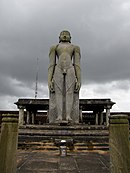 | Karkala | Uttara Kannada | c.1431-1432 | The monolith of Bahubali here stands twelve and half meters tall. |
| Parshwanatha Basadi (Jain) [32] [33] |  | Gerusoppa | Uttara Kannada | 1581 | The Basadi is also called Ratnatraya Badasi and was built by Rangapparajodeya. It has shrines for Neminatha, Parsvanatha and Vardhamana. |
| Shantappa Naika Tirumala [34] [35] | Bhatkal | Uttara Kannada | 1555 | Built by Shantappa Nayaka | |
| Virupaksha [34] [36] | Gokarna | Uttara Kannada | 1570 | Built by Queen Virambika | |
| Bala Kini Raghunatha [34] [37] | Bhatkal | Uttara Kannada | 1590 | Built by Bala Kini | |
| Khetapai Narayan [38] [39] | Bhatkal | Uttara Kannada | 1540 | Built by local chief Ketapayya | |
| Bahubali monolith (Jain) [40] |  | Venur | Uttara Kannada | c.1606 | The monolith was built by the local Ajila Chiefs. |
| Gangadhareshvara [41] [42] |  | Shivagange | Bangalore rural | c.1600 | Shivagange was the principal seat of the Gowda rulers, the founders of Bangalore. Portraits of Kempe Gowda I (dated c.1608) and his two brothers are installed in the rock cut chamber of the temple. |
| Gavi Gangadhareshvara [43] |  | Bangalore | Bangalore | c.1600 | The cave temple was built by Kempe Gowda I in the 16th century. |
| Kollur Mookambika [44] |  | Kollur | Udupi | c.1616 | Built by Venkatappa Nayaka of the Nayaka Dynasty of Keladi |
| Chandranatha(Jain) [32] [45] | Bhatkal | Uttara Kannada | c.1484 | The temples was built by Hadavalli prince Salvendra | |
| Aryadurga [34] | Ankola | Uttara Kannada | 1505 | ||
| Partakali Jivottam [34] | Gokarna | Uttara Kannada | 1560 | ||
| Mahalasa Narayan [34] | Kumta | Uttara Kannada | 1560 | ||
| Rameshwara [46] [47] |  | Keladi | Shimoga | Early 16th century | The Rameshvara shrine was built by Chudappa Nayaka (c.1499–1530), the founder of the dynasty, and the adjoining Veerabhadra shrine was built by his successor Sadashiva Nayaka (r.1530–1566). |
| Aghoreshwara [48] [49] |  | Ikkeri | Shimoga | Late 16th century | The Aghoreshwara shrine was built by Dodda Sankanna Nayaka (or Sankanna I, r.1566–1570) who moved his capital from Keladi to Ikkeri. |
| Mahaganapati Mahamaya [34] | Shirali | Uttara Kannada | 1560 | ||
| Ishwara [34] | Baindur | Udupi | 16th century | ||
| Balarama [34] | Malpe | Dakshina Kannada | 16th century | ||
| Indrani [34] | Manipal | Dakshina Kannada | 16th century | ||
| Bhoga Nandishwara [1] [50] |  | Nandi | Chikkaballapura | 15th century | A pavilion with elegant pillars between the two major shrines, a navaranga mantapa (pavilion) with Yali pillars and a large stepped temple tank (kalyani or pushkarni) were added in this period. |
| Kanakachalapathi [51] [52] |  | Kanakagiri | Koppal | c.1509–1529 | |
| Ananthasayana [53] |  | Ananthasayanagudi | Ballari | c.1524 | |
| Mahaganapati [54] | Kurudumale | Kolar | 16th century | ||
| Teru Malleshwara [55] |  | Hiriyur | Chitradurga | c.1466 | |
| Nandi (Bull) [56] [57] |  | Bengaluru | Bangalore Urban | c.1509–1529 | |
| Someshwara [58] [59] |  | Bengaluru | Bangalore Urban | 16th century | One of the oldest temples in Bangalore, major additions or modifications to which were made during the late Vijayanagara Empire period under the rule of Kempe Gowda I (Hiriya Kempe Gowda). |
| Gavi Gangadhareshwara Temple [59] |  | Bengaluru | Bangalore Urban | 16th century | Cave temple and one of the oldest temples in Bangalore, dates from the late Vijayanagara Empire period, built by Kempe Gowda I (Hiriya Kempe Gowda). |
| Gangadhareshwara Temple, Shivagange [59] |  | Shivagange | Bangalore Rural | 16th century | Cave temple, dates from the late Vijayanagara Empire period, built by Kempe Gowda I (Hiriya Kempe Gowda). |
| Lakshmikanthaswamy [60] | Tumkur | Tumkur | c.1560 | ||
| Gopala Krishnaswami [61] |  | Thimmalapura | Vijayanagara | c.1539 | |
| Shiva [61] |  | Thimmalapura | Vijayanagara | c.1539 | |
| Ranganatha [62] |  | Rangasthala | Chikkaballapura | c.1600 | |
| Gaurishvara [63] |  | Yelandur | Chamarajanagar | c.1500 | The temple was constructed by a local chief Singedepa Devabhupala of the Hadinadu chiefdom, a feudatory of the 16th century Vijayanagara Empire |
| Jambunatheshwara [64] |  | Hospet | Vijayanagara | c.1500 | |
| Vijayanarayana [63] [65] |  | Gundlupet | Chamarajanagar | 15th century | |
| Ranganatha [66] |  | Magadi | Ramanagara | c.1524 | The gopura (tower) were built by the Vijayanagar emperor Krishnadevaraya in the 16th century and was later renovated by King Jayachamaraja Wodeyar of the Mysore Kingdom. |
| Someshwara [67] [68] |  | Magadi | Ramanagara | c.1569 | Built by Kempe Gowda I, the founder of Bangalore |
| Gunja Narasimhaswamy [69] |  | Tirumakudal Narasipur | Mysore | 16th century | The temple was under the patronage of the local governor of Mysore, during the Vijayanagara rule over South India. |

